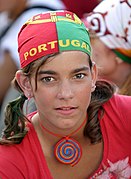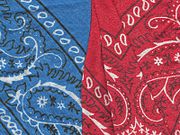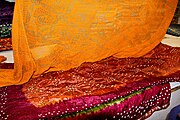Baby Pitbulls With a Blue Bandana on Your Head Blue Bandanas With the Letter F

A woman wearing a blue bandana on her head
A kerchief (from the Old French couvrechief, "cover head"), also known as a bandana or bandanna, is a triangular or square piece of cloth tied around the head, face or neck for protective or decorative purposes. The popularity of head kerchiefs may vary by culture or religion, often being used as a Christian headcovering by women of the Anabaptist, Eastern Orthodox, and Plymouth Brethren denominations,[1] as well as by some Orthodox Jewish and Muslim women.
The neckerchief and handkerchief are related items.
Types [edit]
Bandana [edit]

A man wearing a red bandana
A bandana or bandanna (from Sanskrit बन्धन or bandhana, "a bond")[2] [3] is a type of large, usually colourful kerchief, originating from the Indian subcontinent, often worn on the head or around the neck of a person. It is considered to be a hat by some. Bandanas are frequently printed in a paisley pattern and are most often used to hold hair back, either as a fashionable head accessory, or for practical purposes. It is also used to tie around the neck to prevent sunburn, and around the mouth and nose to protect from dust inhalation or to hide the identity of its wearer.
Bandanas originated in India as bright coloured handkerchiefs of silk and cotton with spots in white on coloured grounds, chiefly red and blue Bandhani. The silk styles were made of the finest quality yarns, and were popular. Bandana prints for clothing were first produced in Glasgow from cotton yarns, and are now made in many qualities. The term, at present, generally means a fabric in printed styles, whether silk, silk and cotton, or all cotton.[4]
The word bandana stems from the Hindi words 'bāndhnū,' or "tie-dyeing," and 'bāndhnā,' "to tie." These stem from Sanskrit roots 'badhnāti,' "he ties," and Sanskrit 'bandhana' (बन्धन), "a bond."[5] In the 18th and 19th centuries bandanas were frequently known as bandannoes.[6]
-

A girl wearing a bandana on her head to support Portugal in football in the colors of that country's flag
-

Red and blue bandanas in traditional paisley patterns
-

Bandanas hanging out
-

-

A man wearing a kerchief around his neck
Oramal [edit]

The Oramal is a traditional kerchief used in Central Asia and the Caucasus (note how it is banded, the neck is usually not covered by it). In some countries like Uzbekistan, it was traditionally used only at home, while in public the paranja was more popular. In other countries, like Kazakhstan, it was commonly used in public. In Kyrgyzstan, the white color is an indication that the woman is married.
As well it was widely used by men at horse riding at summertime instead of cap.
Headscarves [edit]
Kerchiefs are also worn as headdresses by Austronesian cultures in maritime Southeast Asia. Among Malay men it is known as tengkolok and is worn during traditional occasions, such as weddings (worn by the groom) and the pesilat.
See also [edit]
References [edit]
- ^ Hume, Lynne (24 October 2013). The Religious Life of Dress: Global Fashion and Faith. Bloomsbury Publishing. ISBN978-0-85785-363-9.
Following the general Anabaptist worldview, Hutterite dress not only emphasizes modesty but also separation from the world. ... The women wear ankle-length skirts or dresses with a blouse, a kerchief-style head covering with polka dots (tiechle), usually black and white, and solid comfortable shoes.
- ^ "Definition of bandanna". Merriam-webster.com. 2012-08-31. Retrieved 2013-03-15 .
- ^ "Bandanna from Dictionary.com". Dictionary.reference.com. Retrieved 2013-03-15 .
- ^ Curtis, H. P. (1921). Glossary of Textile Terms. Marsden & Co. Ltd.
- ^ "Bandanna from Dictionary.com". Dictionary.reference.com. Retrieved 2017-06-10 .
- ^ Yule and Burnell (2013), "Bandanna", p.78.
- Additional sources
![]()
![]()
Wikimedia Commons has media related to Kerchiefs.
- Hilger, Laura (November 2020). "The Global History of the Bandana". Smithsonian Magazine.
- Yule, Henry, & A.C. Burnell (2013). Hobson-Jobson: The Definitive Glossary of British India. (Oxford, England: OUP). ISBN 9780191645839.
External links [edit]
- How to tie a bandanna
Source: https://en.wikipedia.org/wiki/Kerchief
0 Response to "Baby Pitbulls With a Blue Bandana on Your Head Blue Bandanas With the Letter F"
Post a Comment